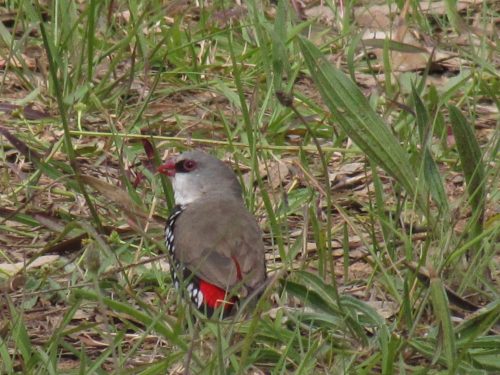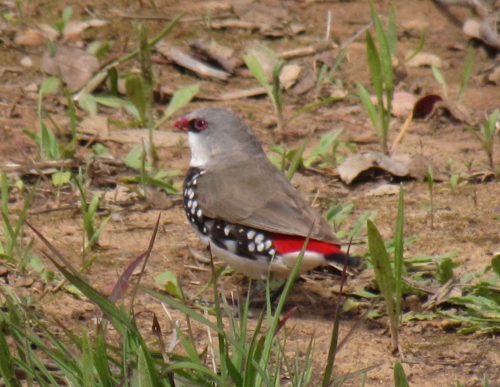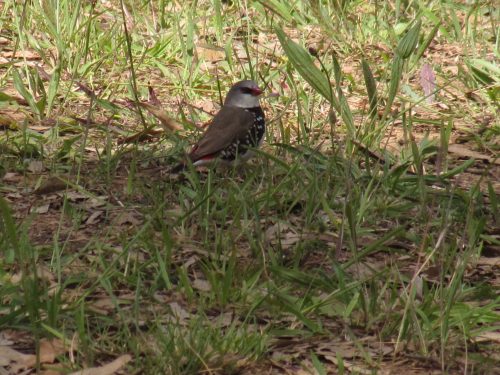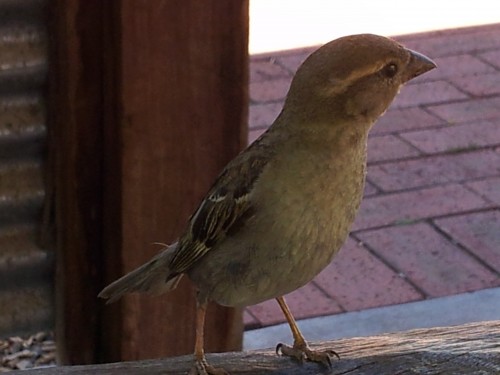Glen Alice in Capertee Valley
Earlier this week I wrote about my first visit to the Capertee Valley late last year. In general, this was a rather disappointing day of birding. I went with such high expectations, but I didn’t realise that I had underestimated the time needed to do this wonderful region justice. The road through the valley is an alternative route from Lithgow (north-west of Sydney) to Mudgee, though some of this section of the road is unsealed.
One really needs a full day to explore this area even superficially. Several days to a week would enable keen birders to really enjoy the delights of this valley. In this way, keen birders would be able to track down many of the wonderful birds of the valley. Along the route I took we noticed at least twenty signs pointing to Birdwatching Sites. Each would be worth stopping at for an hour or two. We only stopped at one, and that was in the small village of Glen Alice. This small settlement has a school, a community hall, an emergency fire station, an old church and several houses. Oh, I forgot – it also has a historic cemetery.
We went for a short drive along the only street before returning to the parking area near the old church. Here we stopped for afternoon tea. While we had our cuppa and some biscuits, I managed to do a little birding. Within seconds of getting out of the car, a solitary Diamond Firetail finch flew in and settled on the ground only a few metres from me. I was able to get a few quickly taken photos before it flew off again. These are the photos I have featured today.
Within the next half hour, I made quite a nice little list of birds seen but didn’t get any more photos – well, not any that are worth showing here. The following species were either seen or heard:
- Grey Butcherbird 1
- Noisy Miner 8
- Diamond Firetail 1
- Australian Raven 4
- Australian Magpie 4
- Red Rumped Parrot 2
- White-plumed Honeyeater 5
- Willie Wagtail 2
- Sacred Kingfisher 1
- Little Black Cormorant 1
- Hooded Robin 1
- Rainbow Bee-eater 2
- Superb Fairywren 2
- Crimson Rosella 2
- Australian Wood Duck 5
- Magpie Lark 2
- Rufous Whistler 1
- Black-faced Cuckoo-shrike 1
- Fuscous Honeyeater 1
Several kilometres out of town in the locality known as Bogee, I added the following species:
- Grey-crowned Babbler 3
- Yellow-rumped Thornbill 3
Related reading:
Some birds of the Artarmon area – and two young birders
I am currently in Sydney visiting my family, including my only two grandchildren. They are very demanding and energetic and this makes me tired, but very satisfied. When we are staying with them I don’t get many opportunities to get out birding. This trip has been a little different and I will write about that in the next few days.
One interesting thing happened this evening. For his fifth birthday in October I gave my grandson a simple, lightweight pair of binoculars. I hasten to add that this was at his request; he’d often seen me using mine and wanted to be like his granddad. We were on the front lawn looking out for any birds we could see. We managed to list the following:
- Australian Raven
- Rainbow lorikeet
- Grey Butcherbird
- Galah
- Laughing Kookaburra
We were just heading off inside for them to go to bed when Miss 2.5 yo came running up to me all excited. She pointed to the Grey Butcherbird perched on the power line about 5 metres away. I guess they are never too young to start getting them interested in birding.
Other birds seen or heard during our nearly three week stay include:
- Pied currawong
- Noisy Miner
- Common Myna
- Crested pigeon
- Australian Brush-turkey
- Sulphur-crested Cockatoo
- Tawny Frogmouth
- Australian Magpie
- Wonga pigeon
- Rock Dove
- Eastern Koel
Good birding.
On the road again
We are on the road again. To be more precise: we have been on the road and are now in Sydney for about a month staying with family for Christmas. We left just over a week ago and travelled from home in Murray Bridge, South Australia, to my son’s home in Artarmon in two days of many hours in the car. Although the distance is just over 1300km we enjoy the journey, taking note of the changing environments as we go.
All the way we are on the lookout for birds. At certain points along the way we stop for meal breaks, or to refuel. On these occasions I usually jot down the birds observed during our break. Additional lists are sometimes made as we drive along, usually when my wife is driving. If either of us sees something special or out of the ordinary I will make a note of that too.
During the morning of the first day we saw many of the usual species seen along the road from Murray Bridge to Ouyen in Victoria. This is predominantly mallee eucalypt country used for wheat and sheep farming. Along the way we saw several family groups of White-winged Choughs. It always amuses me that they do not merely walk or hop along the ground; it’s more of a swagger. If pressed hard they will fly off, their white wing patches showing up clearly. This easily identifies them from the many Australian Magpies and Little Ravens along this stretch of highway.
Also along this stretch I am also on the lookout for the way the magpies change from the white-backed sub-species to the black-backed. Intermediate hybrids are also worth looking for. As for the ravens it is a harder task. The further east one travels the more Australian Ravens can be found. The only sure way of telling them apart from the Little Ravens is to hear them call, not a practical solution driving at 110kph.
Along this first leg of the journey we also saw a few Grey Currawongs as they glided across the road in front of us, many Willie Wagtails fluttering around in search of breakfast, the occasional Nankeen Kestrel soaring or hovering over the fields, and flocks of Galahs glowing pink in the morning sun. A highlight was several brief sightings of Dusky Woodswallows, always a nice species to see.
Morning tea at Lameroo added Welcome Swallows, Australian Wood Duck, Crested Pigeon and Magpie Lark to the list. I didn’t add the feral domestic ducks which live around the artificial lake.
Coming into Ouyen for lunch I saw the only Brown Falcon sighted on the journey to Sydney. Typically, it was perched on the pole of a telephone line. While having lunch a female House Sparrow cheekily perched on the picnic table about 30cm from my lunch. It was close enough to get a few good shots with my phone (see below).
Other species added to my growing list while we ate lunch included Spiny-cheeked Honeyeater, European Blackbird, Common Starling, Yellow-throated Miner, Singing Honeyeater and White-plumed Honeyeater.
Tomorrow: from Ouyen, Victoria to Narrandera, NSW.
Tubbo Station, central New South Wales
Sydney Trip Report June 2011
On the second day of our return trip from Sydney we drove through Tubbo Station country near Darlington Point which is between Narrandera and Hay in the Riverina region of New South Wales. This large merino sheep station extends over nearly 19,000 hectares in size and runs over 10,000 sheep plus cattle. It also has extensive irrigation areas.
As we were driving along I jotted down a list of birds seen as we travelled the highway through the station. This is not the ideal birding experience and I would love to have stopped a few times but we had plenty of ground to cover on the day. While my wife was driving I made the following list of birds seen:
Apostlebird
Galah
Australian Raven
Sulphur-crested Cockatoo
Australian Magpie
Australian Magpie Lark
Yellow Rosella
Spotted Harrier
White-necked Heron
White-faced Heron
Australian Wood Duck
Laughing Kookaburra
It’s not a big list but it has some interesting species in it. We saw very few Apostlebirds on our trip so it was good to see them feeding on the roadside. Yellow Rosellas, a sub-species of the Crimson Rosella, is always a delight to observe. Spotted Harriers are wonderfully majestic birds as the soar over the paddocks and the herons were obviously taking advantage of the fact that there were many irrigation channels in the area.
Probably the highlight for me was seeing three White-necked Herons flying together. This species has been something of a bogey bird for me. Although widespread and common in my home territory, I have observed this species on only a handful of occasions over the last two decades.
The photo below was taken only a few days ago at Mannum in South Australia.
A bush picnic – but few birds
Sydney Trip Report June 2011
On the first day of our trip to Sydney earlier this year we stopped for a picnic lunch at a roadside picnic area near the small township of Walpeup. This farming community is between Ouyen in NW Victoria and the South Australian border. This picnic area came with a short nature trail through the native scrub next to the road. Some of the plants were of particular interest to my wife who is an avid grower of Australian native plants.
Despite the day being quite sunny, the weather was most unpleasant. A stiff breeze blew from the south bringing bitterly cold air all the way from the Antarctic – or that’s what it felt like. The birding was very poor and I only heard a handful of individual birds calling. I didn’t actually see anything.
The following is a very short list of birds heard over the 20 minute period we were there:
- Singing Honeyeater
- White-browed Babbler
- Grey Shrike-thrush
- Little Raven
Oh well – you get days like that.
Good birding – and I hope you get a better list than that!





